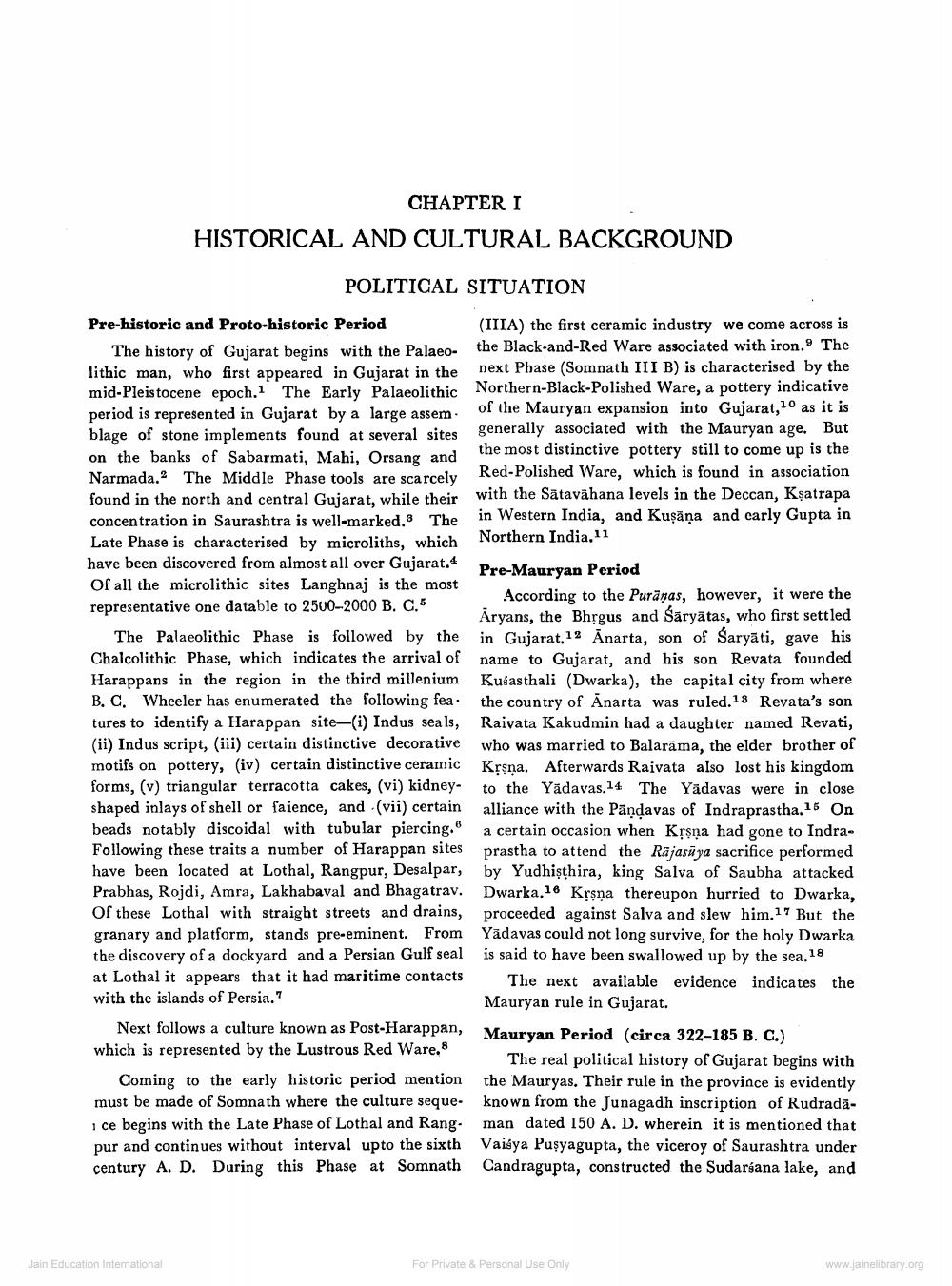________________
CHAPTER I HISTORICAL AND CULTURAL BACKGROUND
POLITICAL SITUATION
Pre-historic and Proto-historic Period
(IIIA) the first ceramic industry we come across is The history of Gujarat begins with the Palaeo- the Black-and-Red Ware associated with iron. The lithic man. who first appeared in Gujarat in the next Phase (Somnath III B) is characterised by the mid-Pleistocene epoch. The Early Palaeolithic Northern-Black-Polished Ware, a pottery indicative period is represented in Gujarat by a large assem
of the Mauryan expansion into Gujarat, 10 as it is blage of stone implements found at several sites generally associated with the Mauryan age. But on the banks of Sabarmati, Mahi, Orsang and
the most distinctive pottery still to come up is the Narmada.The Middle Phase tools are scarcely
Red-Polished Ware, which is found in association found in the north and central Gujarat, while their with the Sātavähana levels in the Deccan, Kşatrapa concentration in Saurashtra is well-marked. The
in Western India, and Kuşāņa and carly Gupta in Late Phase is characterised by microliths, which Northern India." have been discovered from almost all over Gujarat.
Pre-Mauryan Period Of all the microlithic sites Langhnaj is the most
According to the Purāņas, however, it were the representative one datable to 2500-2000 B. C.
Aryans, the Bhțgus and Sāryātas, who first settled The Palaeolithic Phase is followed by the in Gujarat.12 Anarta, son of Saryāti, gave his Chalcolithic Phase, which indicates the arrival of name to Gujarat, and his son Revata founded Harappans in the region in the third millenium Kušasthali (Dwarka), the capital city from where B. c. Wheeler has enumerated the following fea. the country of Anarta was ruled.18 Revata's son tures to identify a Harappan site-(i) Indus seals, Raivata Kakudmin had a daughter named Revati, (ii) Indus script, (iii) certain distinctive decorative who was married to Balarama, the elder brother of motifs on pottery, (iv) certain distinctive ceramic Krsna. Afterwards Raivata also lost his kingdom forms, (v) triangular terracotta cakes, (vi) kidney to the Yadavas.14 The Yadavas were in close shaped inlays of shell or faience, and (vii) certain alliance with the Pandavas of Indraprastha. 16 On beads notably discoidal with tubular piercing, a certain occasion when Krsna had gone to IndraFollowing these traits a number of Harappan sites prastha to attend the Rajasüya sacrifice performed have been located at Lothal, Rangpur, Desalpar, by Yudhisthira, king Salva of Saubha attacked Prabhas, Rojdi, Amra, Lakhabaval and Bhagatrav. Dwarka.16 Krsna thereupon hurried to Dwarka, Of these Lothal with straight streets and drains, proceeded against Salva and slew him.17 But the granary and platform, stands pre-eminent. From Yadavas could not long survive, for the holy Dwarka the discovery of a dockyard and a Persian Gulf seal is said to have been swallowed up by the sea. 18 at Lothal it appears that it had maritime contacts The next available evidence indicates the with the islands of Persia."
Mauryan rule in Gujarat. Next follows a culture known as Post-Harappan, Mauryan Period (circa 322-185 B. C.) which is represented by the Lustrous Red Ware.8
The real political history of Gujarat begins with Coming to the early historic period mention the Mauryas. Their rule in the province is evidently must be made of Somnath where the culture seque. known from the Junagadh inscription of Rudrada1 ce begins with the Late Phase of Lothal and Rang. man dated 150 A. D. wherein it is mentioned that pur and continues without interval upto the sixth Vaisya Puşyagupta, the viceroy of Saurashtra under century A. D. During this Phase at Somnath Candragupta, constructed the Sudarsana lake, and
Jain Education International
For Private & Personal use only
www.jainelibrary.org




